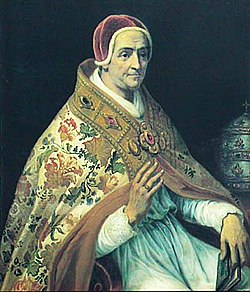Antipope
| Christ died for our articles about Christianity |
| Schismatics |
| Devil's in the details |
An antipope is someone who upon contact with a pope causes them both to be annihilated is against popes claims to be Pope, but the Roman Catholic Church does not recognise them as such. Rival claimants to the papacy have appeared from the 3rd century CE onwards.[1] The most significant instance of an anti-Papacy actually impacting world affairs was circa 1449 when rival administrations in Avignon (a city in France) and Rome in the Papal States claimed validity. This was an instance of late Crusades-era politicking where the Church was also the State (l'état c'est moi before Louis XIV). Modern anti-Pope movements generally are written off as schismatic blips on the radar by both the Vatican and most Catholics and point-and-laugh opportunities by others.
There were many people during the 20th century who claimed to be Pope, and there are some claimants in the world today.[2] Apart from the recognized Pope in Vatican City, the Coptic Popes, and the Pope and Patriarch of Alexandria and All Africa, they all have tiny followings. Sedevacantist Catholics typically argue that John Paul II, Benedict XVI, and Francis are all antipopes.[3] On December 2023, Italian Catholic priest Ramon Guidetti called Francis a "masonic Jesuit tied to a group of globalists, an antipope usurper" during a mass. Guidetti was excommunicated the following day for committing "an act of a schismatic nature".[4] That's lightning speed for a church that has failed to do very much about its pedophile problem.[5]
The Middle Ages[edit]
During the Middle Ages, there were times when there were multiple claimants to the papacy, which could call upon entire countries for their support. The most notable such occasion was the Western Schism, with one Pope in Rome, with recognition by Denmark, England, Norway, Poland, Sweden, Hungary, and parts of Germany, and another Pope in Avignon with recognition from France, Naples, Scotland, Spain, and other parts of Germany. The Council of Pisa was held in an attempt to resolve the issue; it ended with the election of a third Pope based in Pisa, but the existing two Popes refused to step down, so now there were three Popes instead. Eventually, the Council of Constance settled the issue — the existing Roman Pope resigned, a new Roman Pope was elected in his place, and the Popes of Avignon and Pisa lost their support. The Roman Catholic Church today only considers the Roman line of Popes to be genuine popes, and considers the lines of Avignon and Pisa to be antipopes instead.[6]
Contemporary antipopes[edit]
- Pope Michael I (David Bawden) (1959–2022), elected in 1990 in Kansas, United States.[7] His Roman Curia consisted of his mother and one monk. Died on August 2nd, 2022.[8]
- Pope Peter III, fourth pope of the Palmarian Catholic Church. As proven by their
drug tripsvisions from Christ, the See of Rome has been transferred to El Palmar de Troya, Spain. All of their clergy are bishops, their liturgical rites have been shortened because their popes are always experiencing visions, and they expanded the dogma of transubstantiation by adding Mary to it, because believing a wafer to be Jesus alone wasn't enough.
See also[edit]
References[edit]
- ↑ Antipope
- ↑ The Modern Anti-Popes
- ↑ Why John Paul II and Benedict XVI were Antipopes and Francis is
- ↑ Italian priest excommunicated for calling Francis ‘antipope usurper’ during Mass by Carol Glatz (January 03, 2024) America: The Jesuit Review.
- ↑ Investigation reveals widespread sexual abuse and cover-ups by Archdiocese of Baltimore (Apr 6, 2023 6:40 PM EST) PBS.
- ↑ This Date in History: Great Schism of the West
- ↑ 10 Most Bizarre People on Earth
- ↑ https://twitter.com/Francis5Domini3/status/1554621541937291264
